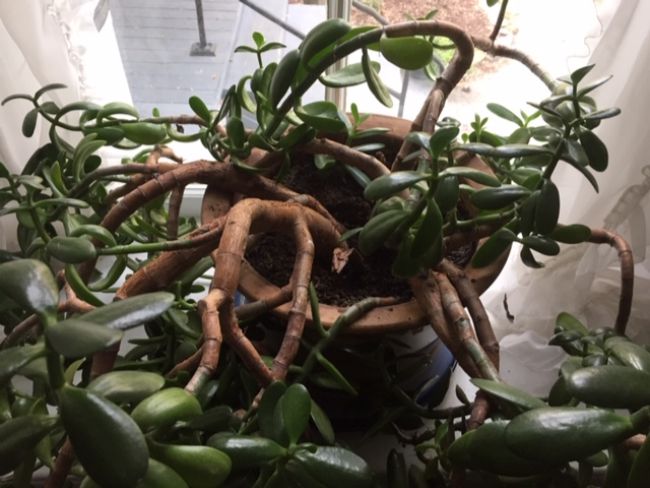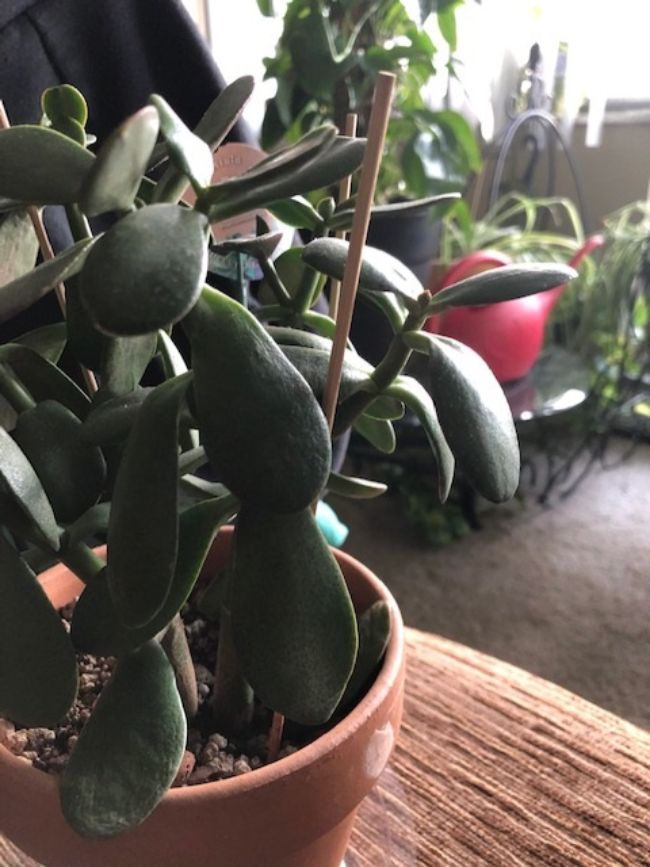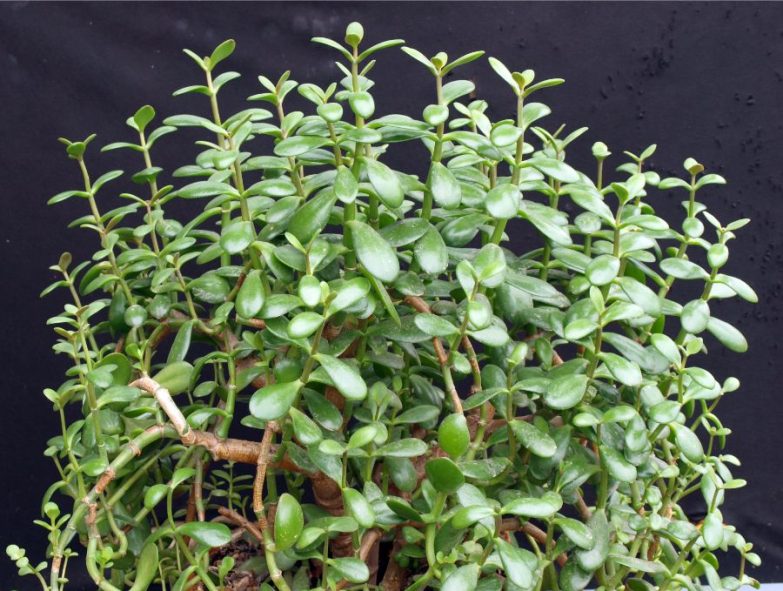The fascinating Jade plant is a favorite of beginners and experienced growers alike. This unique succulent is so durable that it’s called the Lucky Plant and is given as a traditional housewarming gift. If you find your jade plant drooping, you may wonder what’s going wrong. Let’s look at what can go wrong and how to fix it.
Why is my jade plant drooping? Root rot from overwatering or poor drainage is the most serious possibility – infected stems wilt before falling off. Underwatering and inadequate light can weaken the stems over time. Repotting, over-fertilization or temperature stress can also cause drooping.
When checking the list of potential reasons, the first thing to rule out is root rot. It may seem logical to water a wilting jade plant, but that could be the killing stroke. Let’s examine the plant more closely to understand its needs and see what’s going wrong.
Overview Of The Jade Plant
The Jade (Crassula ovata) is an African succulent that has become a popular houseplant worldwide. Because they thrive in a dry climate, they love the arid conditions of most homes – a nice break from struggling to provide humidity for tropical plants.
Also called the Money Tree for its fat oval leaves, the Jade Plant is long-lived and can be passed down for generations. Undemanding, it doesn’t like being disturbed and thrives on benign neglect. It makes a great set-and-forget houseplant.
Another reason for their popularity is their easy propagation: new plants root readily from leaves or stems that fall on the soil. The Jade’s one unfriendly aspect is toxicity to pets, including horses; though, it’s only mildly poisonous to humans.
Why Is My Jade Plant Drooping?
Let’s look at each cause in turn to help you identify why your Jade plant is drooping or wilting. We’ll start with watering issues as these are the most common. Look at each cause in turn and you’ll soon be able to identify and fix your Jade plant.
I’ve written several other articles about common Jade plant issues, as well as a complete guide to Jade plant care, so read the following articles for further information as required.
- Jade Plant Overwatering – Symptoms And Solutions
- Why Is My Jade Plant Turning Red?
- Why Does My Jade Plant Have White Spots On The Leaves?
- Why Is My Jade Plant Dropping Leaves?
- How To Care For A Jade Plant

1. Watering Problems
Overwatering is dangerous for Jade plants. Too little water is a lot better than too much.
Not enough water may weaken the plant and indirectly cause drooping, but overwatering creates a more insidious and deadly problem. Not only will the stems droop, they’ll turn mushy and drop off. If allowed to progress, root rot will kill the whole plant. Goodbye heirloom.
Problems from overwatering can look similar to underwatering, since the roots of a plant infected with root rot can’t transport water and nutrients to the leaves.
The sure way to tell the difference is to check the roots. Upend the pot and gently remove the plant. If the roots are white and odorless, they are healthy … if they’re brown, mushy and smell bad, you have a situation to deal with.
Root Rot
Jade plants are built to survive in dry conditions and can’t cope with wet soil. Overwatering drowns their roots and creates anaerobic conditions for pathogens of decay.
Besides getting mushy brown roots, the stems of a plant in crisis turn soft and damp. Try to save it with these steps:
- Cut away the affected roots and stems, and knock away old soil. Be strong. You can only save the parts that haven’t started to rot. Consider treating the cuts with fungicide.
- Repot in fresh, dry soil. Don’t reuse the old soil with active pathogens.
- Put the plant in good light and let it rest in dry soil for at least a week.
- Carefully begin a proper watering regimen.
The plant can recover if it’s not too far gone.
How To Water A Jade Plant To Prevent Drooping
A Jade’s soil should be completely dry at least half-way down the pot before rewatering. Insert your finger, a moisture meter, or a wooden chopstick to check. Some growers lift the pot to see if it’s still heavy with moisture.
Indoors, watering once every three to four weeks in the warm season is about average. The plant goes dormant over the winter and needs even less. Don’t depend upon a preset schedule, however: Only water when the soil is sufficiently dry.
When you do water a Jade plant, soak it thoroughly. It’s better to place the pot in a bucket or sink of water than to sprinkle from the top. When soil gets very dry it can resist water, especially if it contains peat. A thorough soaking makes sure the soil is saturated and all the roots are watered.
Afterwards, let the plant drain for at least five minutes. Empty any cache trays below the pot to ensure there’s no stagnant water under the roots.
Thoroughly soaking the soil mimics the infrequent rainstorms the plant enjoys in its natural habitat. It’s fun to see the leaves plump up!
2. Poorly-Draining Soil
Poorly draining soil is a primary cause of root rot, so it’s crucial to get the mix right. Luckily, it’s really easy. A half-and-half combination of cactus potting soil and perlite or pumice works great.
One amendment to be wary of is peat, because it has a tendency to repel water when dry. If you already have a mixture with peat, realize it will take extra soaking to re-moisten it.

3. Low Light
Insufficient light causes legginess and thin stems which droop under the weight of heavy leaves. The leaves will also grow smaller and darker and lose their shine in low light. You may not see the problem coming and only notice when, after watering, the leaves fill up and drag the stems down.
If you give the plant enough light, new stems will be strong enough to carry the foliage. Skinny stems don’t thicken up, unfortunately, even if you start giving them the right light—improved conditions only affect future growth. The solution is to prune away the thin stems and let the plant regrow.
Outdoors, Jade plants like full to partial sun, but not scorching hot rays. Sunburn shows up as brown spots on the leaves, so acclimate an indoor plant when moving it to a sunny spot outside.
Outdoor sunlight is very intense, but indoors they’ll take all the light you can give them. Four hours a day of direct sun each day is recommended. A sunny window with a southern exposure is ideal. If necessary, a grow light can fill in the missing lumens.
4. Extremes Of Temperature
Jade plants are tolerant of dips down to 40°F (4°C), but they can’t take a frost. Excessive cold or heat can cause your Jade plant to wilt, as can temperatures that rapidly fluctuate.
They like 65°F (18°C) to 75°F (24°C) during day with cooler temps in the evening: a mild desert climate. 50°F (10°C) to 55°F (°13C) at night is ideal.
5. Over Fertilizing Can Cause Drooping
Jade plants aren’t heavy feeders and do well in poor soil, but they still need nutrition to grow strong stems and avoid drooping. A yearly dose in the spring or summer is usually fine, though some owners choose to make light applications monthly in the growing season. Whichever you prefer, don’t feed them during their cool-weather dormancy.
Fertilizer can burn the shallow roots and shock the plant, so apply a liquid solution to moistened soil. Use a quarter-strength dilution of a balanced fertilizer. Limited worm castings or compost are a good addition: they provide a safe—though imprecise—base of nutrition.
6. Repotting Can Cause Drooping
The rule with Jades is to never try to pot your way out of health issues. Repotting is much more traumatic to the plant than pruning.
Jades don’t mind being rootbound—they’ll just stop growing larger. If you want to encourage growth, you can repot them in a container one size up every two or three years. An older plant will be fine with repotting or soil refreshment every four or five years.
Repot with dry soil in early spring before the growing season starts. Let the plant rest in its new soil a week before watering. Don’t fertilize for at least a month to avoid burning new roots.

Prune Your Jade Plant To Prevent Drooping
Jades are easy to shape through pruning and amenable to being rootbound in small containers. However, its heavy leaves tend to make the Jade top-heavy and prone to drooping if the stems are weak. Pruning is usually the best solution. Don’t worry: Jade plants are quite amenable to pruning and are easy to shape.
Use a sharp, sterilized blade and cut just below a node or where a stem meets its main branch. Healthy growth will emerge below the cut.
If you’re nervous because the plant needs a lot of pruning, you can do it in stages. It’s easy to propagate the stem and leaf cuttings: just let them air dry overnight to seal, and plant in damp soil.
Planting Tips To Prevent Your Jade Plant Drooping
Here are tips to keep your Jade upright:
- As exotic and intriguing as the plant is, resist the temptation to fuss over it. Jades are sensitive to change and enjoy neglect.
- Jades prefer to stay in one place, so put it in a good location and don’t move it.
- Watch the leaves. It’s normal for them to wrinkle slightly as watering time approaches, but they shouldn’t become discolored or fall off in groups.
- An unglazed pot is the best Jade container—put it into a larger decorative pot if it bothers you. Add sphagnum moss on top if the inner pot shows.
- White spots on leaves are typically harmless mineral deposits coming through. If your tap water is heavily mineralized consider using filtered water.
- Periodically wipe the leaves or rinse them off at watering time. This opens leaf pores, lets the sun through, and helps discourage pests.
- It’s common to place stones on the soil around a Jade, but it’s not a great idea. It slows drying and inhibits the probing you need to do to decide when to water.
- If your plant has you worried, consider propagating a couple of its leaves for insurance.
Diseases And Pests
Healthy Jade plants aren’t normally prone to disease, and the infestations they get are usually easy to treat. In any case, the symptoms of their most common pest, mealybugs, are dented or pitted leaves instead of wilted stems. Another frequent guest, scale, causes leaf yellowing well before drooping is seen.
These pest problems are usually solved easily by wiping the leaves with alcohol or neem oil, or by mixing diatomaceous earth into the soil.

